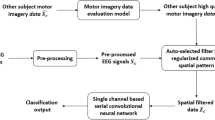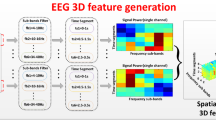Abstract
Robust classification of electroencephalogram data for motor imagery recognition is of paramount importance in brain–computer interface (BCI) domain. Since EEG signals are highly subject-dependent, inter-subject variations can greatly impair the robustness of motor imagery (MI) classification. Therefore, this study introduces a precisely designed deep learning architecture namely compact convolutional EEG classifier (CCEC) which achieves better performance in both precision and efficiency. Specifically, the recorded EEG signals are first denoised using multiscale principal component analysis (MSPCA) technique. Then, such raw EEG data are converted into small tempo-spatial data matrices with a two-step signal preprocessing technique. Finally, the tempo-spatial matrices are fed to the proposed CCEC model for MI classification. Experimental results on two benchmark datasets demonstrate that the proposed model not only performs exceptionally well in subject-specific case with an average classification accuracy of 98.2% on dataset 1 but also shows a reasonable average classification accuracy of 72.64% in the subject-independent case. Additionally, with a mere 10% adaptation to subject-specific data, a further improvement of 18% is achieved, thus attaining a noteworthy 90% accuracy in the inter-subject classification. Results also reveal that the proposed CCEC model is highly robust to noisy data, ensuring reliable performance in real-world scenarios.





Similar content being viewed by others
Availability of data and materials
The dataset underlying the results presented in this paper could be obtained from corresponding author upon reasonable request, and the relevant code of the experiment will be published at https://github.com/
References
Peksa, J., Mamchur, D.: State-of-the-art on brain–computer interface technology. Sensors 23(13), 6001 (2023)
Jiping, Z.: Brain computer interface system, performance, challenges and applications. J. Comput. Nat. Sci 3, 46 (2023)
ARI, M.: Brain-computer interfaces: exploring the convergence of medicine and technology p. 24 (2023)
Wang, J., et al.: EEG-based continuous hand movement decoding using improved center-out paradigm. IEEE Trans. Neural Syst. Rehabilitat. Eng. 30, 2845 (2022)
Arpaia, P., et al.: How to successfully classify EEG in motor imagery BCI: a metrological analysis of the state of the art. J. Neural Eng. 19(3), 031002 (2022)
Khan, M., et al.: Review on motor imagery based BCI systems for upper limb post-stroke neurorehabilitation: from designing to application. Comput. Biol. Med. 123, 103843 (2020)
Choi, J., Huh, S., Jo, S.: Improving performance in motor imagery BCI-based control applications via virtually embodied feedback. Comput. Biol. Med. 127, 104079 (2020)
Teo, W.P., White, D., Macpherson, H.: Using noninvasive methods to drive brain–computer interface (BCI): the role of electroencephalography and functional near-infrared spectroscopy in BCI. in Smart Wheelchairs and Brain-Computer Interfaces (Elsevier, 2018), pp. 33–63
Murthy, C., Sridevi, K.: Design and implementation of hybrid techniques and DA-based reconfigurable FIR filter design for noise removal in EEG signals on FPGA. WSEAS Trans. Syst. Cont. 17, 324 (2022)
Kanoga, S., Kanemura, A., Asoh, H.: Multi-scale dictionary learning for ocular artifact reduction from single-channel electroencephalograms. Neurocomputing 347, 240 (2019)
Madduri, V., et al.: A review of methods for suppression of muscle artifacts in scalp EEG signals. in AIP Conference Proceedings (AIP Publishing, 2023)
Chen, X., et al.: Removal of muscle artifacts from the EEG: a review and recommendations. IEEE Sens. J. 19(14), 5353 (2019)
Yong, X., Ward, R., Birch, G.: Generalized morphological component analysis for EEG source separation and artifact removal. in 2009 4th International IEEE/EMBS Conference on Neural Engineering (IEEE, 2009)
Sadiq, M., et al.: Motor imagery BCI classification based on novel two dimensional modelling in empirical wavelet transform. Electron. Lett. 56(25), 1367 (2020)
Yu, X., et al.: A new framework for automatic detection of motor and mental imagery EEG signals for robust BCI systems. IEEE Trans. Instrument. Measure. 70, 1 (2021)
Shovon, T., et al.: Classification of motor imagery EEG signals with multi-input convolutional neural network by augmenting STFT. in 2019 5th International Conference on Advances in Electrical Engineering (ICAEE) (IEEE, 2019)
Jiang, A., et al.: Efficient CSP algorithm with spatio-temporal filtering for motor imagery classification. IEEE Trans. Neural Syst. Rehabilitat. Eng. 28(4), 1006 (2020)
Das, R., et al.: FBCSP and adaptive boosting for multiclass motor imagery BCI data classification: a machine learning approach. in 2020 IEEE International Conference on Systems, Man, and Cybernetics (SMC) (IEEE, 2020)
Sadiq, M., et al.: A matrix determinant feature extraction approach for decoding motor and mental imagery EEG in subject-specific tasks. IEEE Trans. Cognit. Develop. Syst. 14(2), 375 (2020)
Liu, X., et al.: Parallel spatial temporal self-attention CNN-based motor imagery classification for BCI. Front. Neurosci. 14, 587520 (2020)
Leoni, J., et al.: State-of-the-art on brain–computer interface technology. Machine Learn. Appl. 9, 100393 (2022)
Li, H., et al.: Motor imagery EEG classification algorithm based on CNN-LSTM feature fusion network. Biomed signal Proc. Cont. 72, 103342 (2022)
Feng, Y., et al.: ICIF-Net: Intra-scale cross-interaction and inter-scale feature fusion network for bitemporal remote sensing images change detection. IEEE Trans. Geosci. Remote Sens. 60, 1 (2022)
Schirrmeister, R., et al.: Deep learning with convolutional neural networks for EEG decoding and visualization. Human Brain Mapping 38(11), 5391 (2017)
Lawhern, V., et al.: EEGNet: a compact convolutional neural network for EEG-based brain–computer interfaces. J. Neural Eng. 15(5), 056013 (2018)
Dai, G., et al.: HS-CNN: a CNN with hybrid convolution scale for EEG motor imagery classification. J. Neural Eng. 17(1), 016025 (2020)
Barmpas, K., et al.: BrainWave-Scattering Net: A lightweight network for EEG-based motor imagery recognition. J. Neural Eng. (2023)
Van Erp, J., Lotte, F., Tangermann, M.: Brain-computer interfaces: beyond medical applications. Computer 45(4), 26 (2012)
Huang, B., et al.: Exploiting asymmetric EEG signals with EFD in deep learning domain for robust BCI. Symmetry 14(12), 2677 (2022)
Jurcak, V., Tsuzuki, D., Dan, I.: 10/20, 10/10, and 10/5 systems revisited: their validity as relative head-surface-based positioning systems. Neuroimage 34(4), 1600 (2007)
Kipf, T., Welling, M.: Semi-supervised classification with graph convolutional networks. arXiv preprint arXiv:1609.02907 (2016)
Sadiq, M., et al.: Exploiting pretrained CNN models for the development of an EEG-based robust BCI framework. Comput. Biol. Med. 143, 105242 (2022)
Sadiq, M., et al.: Motor imagery BCI classification based on multivariate variational mode decomposition. IEEE Trans. Emerg. Top. Comput. Intell. 6(5), 1177 (2022)
Zhang, K., et al.: Adaptive transfer learning for EEG motor imagery classification with deep convolutional neural network. Neural Netw. 136, 1 (2021)
Fushiki, T.: Estimation of prediction error by using K-fold cross-validation. Statist. Comput. 21, 137 (2011)
Santamaria-Vazquez, E., et al.: EEG-inception: a novel deep convolutional neural network for assistive ERP-based brain-computer interfaces. IEEE Trans. Neural Syst. Rehabilitat. Eng. 28(12), 2773 (2020)
Miao, M., et al.: Spatial-frequency feature learning and classification of motor imagery EEG based on deep convolution neural network. Comput. Math. Methods Med (2020)
Funding
This research is supported in part by the higher education research fund (International Talent Training Special) (GJGZMS202201), the postgraduate education research fund (2022AJ13), and education & teaching reform research project (2022JGZ14) of Northwestern Polytechnical University.
Author information
Authors and Affiliations
Contributions
Z. Fan, X.Y. and M. Z. Aziz proposed the main idea and designed the main aspects of the project; W. Haider and M. Z. Aziz conceived and designed the experiments; M. A. Abbasi and H. F. Abbasi designed and implemented all the software required to performed the experiments, and performed the experiments; X. Yu and M. Z. Aziz evaluated the data; Z. Fan and X. Yu finalized the paper writing, review, and editing.
Corresponding author
Ethics declarations
Conflict of interests
The authors declare no potential conflict of interests.
Ethical Approval
Ethical approval was not sought for the present study because the datasets utilized in this study are publicly available.
Additional information
Publisher's Note
Springer Nature remains neutral with regard to jurisdictional claims in published maps and institutional affiliations.
Rights and permissions
Springer Nature or its licensor (e.g. a society or other partner) holds exclusive rights to this article under a publishing agreement with the author(s) or other rightsholder(s); author self-archiving of the accepted manuscript version of this article is solely governed by the terms of such publishing agreement and applicable law.
About this article
Cite this article
Abbasi, M.A., Abbasi, H.F., Aziz, M.Z. et al. A novel precisely designed compact convolutional EEG classifier for motor imagery classification. SIViP 18, 3243–3254 (2024). https://doi.org/10.1007/s11760-023-02986-1
Received:
Revised:
Accepted:
Published:
Issue Date:
DOI: https://doi.org/10.1007/s11760-023-02986-1




